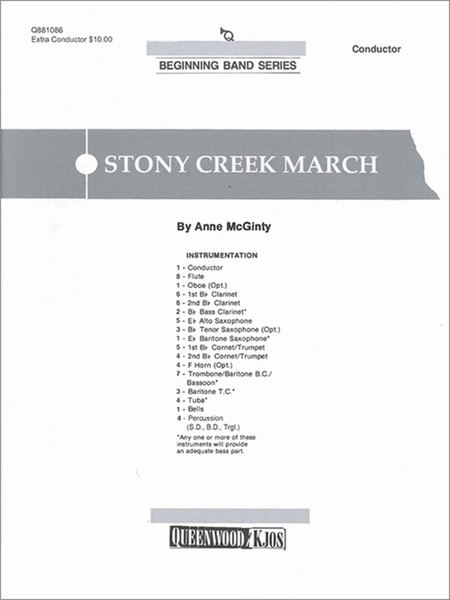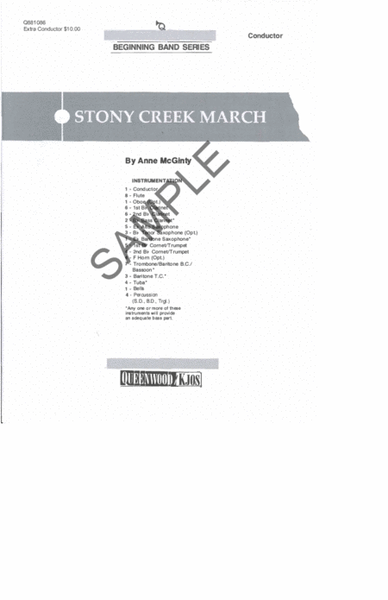Stony Creek March - Score
-
Ships in 1 to 2 weeks
Details
Description
SKU: KJ.Q881086
Composed by Anne McGinty. Queenwood Beginning Band Series. Band. Score. 8 pages. Queenwood Publications #Q881086. Published by Queenwood Publications (KJ.Q881086).9 x 12 inches.
STONY CREEK MARCH is named for a shallow creek from the composer's childhood. It was possible to march across the creek by stepping on stones - except for two stones that were father apart from the others and required two giant steps, which the composer has represented musically within this march.
Maintain a steady tempo of quarter note equals 116. The quarter note accompaniment should be less than full value. The length is easily realized by saying the word "tum" which provides both an attack and a release. The bass drum solo in the introduction should be played with the left hand dampening the left drum head. The right hand should play the accented quarter note with a strong stroke in the center of the head, exactly on beat. A firm wrist will help in the execution. The clarinets and alto saxophone have the melody at m.5. Measure 13 is the first musical representation of the giant steps, so bring out both groups of three by slightly lengthening or stressing the first beat of m.13 and the second beat of m.14. Bring out the imitative part in the flute, optional oboe and bells on the repeat. At the giant steps, m.13, they play the arpeggio pattern descending versus the ascending parts in the melody. From m.25-28 make sure the quarter rest is exactly one beat and in tempo. In effect, the accompaniment chords have a four-measure decrescendo from mezzo forte to piano. At m.25 make sure those with the concert Db have the correct fingering, as this may be a new note for some. The modal Eb-Db harmony continues until m.37. The melody has also been altered to the modal and now contains concert Db as well. Two more "giant steps" occur at m.37-39 and again at m.41-43, although they are not so obvious because of the moving optional bass line. Bring out the snare drum and the accented notes in these measures to reinforce the "giant step" idea. Carefully tune the Eb, F and G chords leading to the interlude. Make sure the third of each chord is indeed a major third. Exaggerate the crescendo in both the woodwind parts and the brass parts at m.50 and m.54 respectively. Bring out the triangle solos in m.52 and m.56. Be sure to use a metal beater and not a snare drum stick. At m.65 the flute, optional oboe and bells have a modified version of the modal tune above a double elongation of the -same tune. Stagger breathing, if possible, to realize the necessary eightmeasure phrase.


 Share
Share